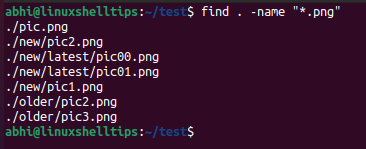
txt PowerShell Find all files on the root of drive D:\ To find all files by extension in the current directory that matches wildcard pattern *.txt PS C:\Temp> Get-ChildItem *.txtĪbove command, find files in the current directory that matches extension.


Let’s understand using PowerShell to find files by name, by extension, or find files recursively with different examples as given below.ĭo you know: Using IIS to get a list of websites in PowerShell! PowerShell Find files by extension in the current directory You can limit the Depth parameter to limit the number of levels to recurse. Using Recurse parameter to get items recursively from all the child containers. The Get-ChildItem cmdlet provides more flexibility for simple or advanced wildcards to find files by a search pattern. Using PowerShell Get-ChildItem cmdlet to show a list of files or directories in one or more locations.
#Find file linux recursive update
Also, after a most recent successful database update on existing files, the locate command does not immediately report the creation of new files.12 Conclusion PowerShell find file using Get-ChildItem The default functional behavior of the locate command is to ignore the existence of the queried file(s) outside its database reach. The locate command is faster than the find command because its file count algorithm is database-oriented and not filesystem-oriented like its counterpart. To use the Linux locate command, you must adhere to the following syntax rule: $ locate … …īy checking the locate command man page ($ man locate), you will also realize that this command can also be used for other viable file-related functionalities.Īlso, even if we bring another popular command ( ls command) to count files in a targeted directory, it will not be recursively deeper and faster to the level of the locate command. With the time command keeping track of the execution time of these two commands ( find and locate), we can note that the locate command recursively dug deeper to produce more file counts in less time. Its command implementation is as follows: $ time locate -c /home/dnyce Second, let us see what results in the locate command will yield for counting files in that same /home/user directory. Your command should look somewhat similar to the following: $ time find /home/dnyce -type f | wc -l In reference to this article guide, the main locate command we are interested in is -c, -count since we are after a standard output that reflects a queried number of file counts.įirst, let us use the find command to count the number of files inside the /home/user directory.
#Find file linux recursive install
Since the find command is already pre-installed on your Linux system, we only need to install the locate command before we initiate their execution speed comparison. To get the speed difference between the find Command and locate command, we will associate their execution with Linux’s inbuilt time command so that we can figure out which approach of recursively counting files is faster. Linux’s Find Command Versus Locate Commandįor demonstration purposes, we will be targeting the number of files inside the /home/user directory of the Linux operating system. Let us compare the two most popular ones. Fast Way to Recursively Count Files in Linuxįew Linux commands stand out in terms of counting files recursively and fast.

However, if we are looking for the fastest means of achieving this article’s objective, we have to be picky and considerate of other viable options. There are several inbuilt Linux-based commands that can easily help you in such circumstances. In this case, you could be having thousands of manually or automatically generated files by system users or programs and want to keep track of their increasing or finite number. Therefore, knowing the location and number of directory files you have to administer/manage is equally important. It is every Linux Administrator’s ambition to be familiar with the Ins and Outs of their operating system architecture. We need to understand or answer the question ‘ why is it important to count files in Linux’.

Before we take an in-depth tour of this article guide, we first need to understand what the article piece is trying to uncover.


 0 kommentar(er)
0 kommentar(er)
